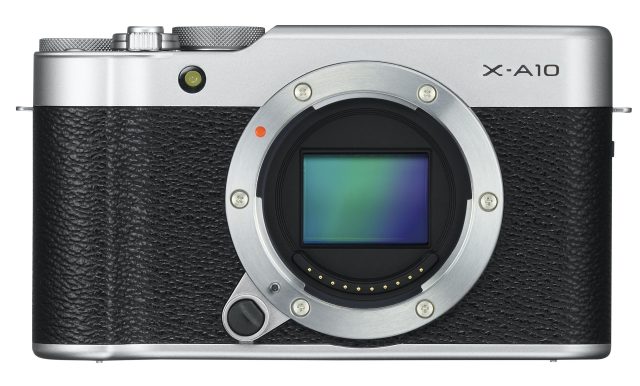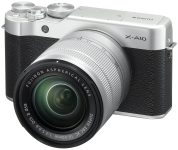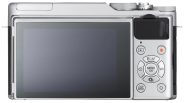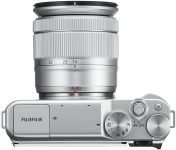Announced
Production status
System
Fujifilm X system cameras
- Fujifilm X-A1
- Fujifilm X-A10
- Fujifilm X-A2
- Fujifilm X-A20
- Fujifilm X-A3
- Fujifilm X-A5
- Fujifilm X-A7
- Fujifilm X-E1
- Fujifilm X-E2
- Fujifilm X-E2S
- Fujifilm X-E3
- Fujifilm X-E4
- Fujifilm X-H1
- Fujifilm X-H2
- Fujifilm X-H2S
- Fujifilm X-M1
- Fujifilm X-Pro1
- Fujifilm X-Pro2
- Fujifilm X-Pro2 Graphite Edition
- Fujifilm X-Pro3
- Fujifilm X-S10
- Fujifilm X-S20
- Fujifilm X-T1
- Fujifilm X-T1 Graphite Silver Edition
- Fujifilm X-T10
- Fujifilm X-T100
- Fujifilm X-T2
- Fujifilm X-T2 Graphite Silver Edition
- Fujifilm X-T20
- Fujifilm X-T200
- Fujifilm X-T3
- Fujifilm X-T30
- Fujifilm X-T30 II
- Fujifilm X-T4
- Fujifilm X-T5
- Fujifilm X-T50
Fujifilm X-A10
APS-C AF digital mirrorless camera • Discontinued
Specification
| Format: | |
| APS-C | |
Imaging sensor: | 23.6 × 15.6mm CMOS sensor |
Resolution: | 4896 × 3264 - 16 MP |
Crop factor: | 1.53x |
Sensor-shift image stabilization: | - |
| Fujifilm X [17.7mm] | |
| Shutter: | |
Type: | Focal-plane |
Model: | Electronically controlled |
Speeds: | 30 - 1/32000 + B |
| Exposure: | |
Exposure metering: | Through-the-lens (TTL), open-aperture |
Exposure modes: | Programmed Auto |
| Aperture-priority Auto | |
| Shutter-priority Auto | |
| Manual | |
| Physical characteristics: | |
Weight: | 331g |
Dimensions: | 116.9x67.4x40.4mm |
Manufacturer description
FUJIFILM Corporation (President: Kenji Sukeno) has announced that it will launch the mirrorless digital camera, the FUJIFILM X-A10; a new addition to the X Series range of cameras that deliver outstanding picture quality.
Despite its compact and lightweight design, the X-A10 combines a 16.3 megapixel sensor with the company’s colour-reproduction technology, refined over more than 80 years, to deliver the premium image quality synonymous to the X Series with ease. This makes the X-A10 an ideal first interchangeable lens camera.
Combining a 16.3 megapixel sensor and Fujifilm’s colour-reproduction technology, refined over more than 80 years, to deliver premium picture quality
The X-A10 combines a 16.3 megapixel APS-C sensor with the image processing engine that achieves Fujifilm’s excellent photo quality. Sharp FUJINON lenses that boast ultimate image resolution, and the proprietary colour-reproduction technology, refined over more than 80 years, allows users to capture premium quality images in any shooting conditions. Fujifilm is particularly renowned for accurately reproducing skin tones, and the X-A10 is built with this advanced skin tone reproduction capability, allowing you to produce high-quality portraiture.
180-degree slide-and-tilt LCD with 100% visibility for facilitating “self-portraits”
The rear LCD employs the slide-and-tilt mechanism so that even when it is tilted by 180 degrees, the LCD is not blocked by the camera, allowing for 100% visibility. The grip is shaped to accommodate both normal shooting and self-portraits. When taking a self-portrait, you can focus and release the shutter by pressing the vertical command dial found directly below your index finger to minimise camera shake. Rotating the tilting LCD upward by 180 degrees activates the Eye Detection AF to automatically adjust the focus on the subject’s eyes. The X-A10 also features the Portrait Enhancer mode for natural and beautiful skin-tone reproduction.
Compact and lightweight camera body with retro design and intuitive operability
The compact and lightweight X-A10 sports a retro design. The use of two Command Dials means you only need a thumb to quickly adjust aperture, shutter speed and exposure settings. Frequently used functions such as white balance, continuous shooting and the self-timer can be assigned to standalone function buttons, eliminating the need to go through the Menu screens to change settings.
Inheriting FUJIFILM X-A2’s popular performance features
Its energy-efficient design means the X-A10 is capable of shooting approx. 410 frames on a single battery charge. When fitted with the standard zoom kit lens “XC16-50mmF3.5-5.6 OIS II,” the camera offers the class-leading minimum working distance of approx. 7cm from the front edge of the lens, allowing close-up macro photography.
Product features
- Outstanding image quality, made possible by the newly-developed 16.3 megapixel image sensor
- Fujifilm’s colour reproduction technology, nurtured through the development of photographic film, captures accurate, warm skin tones, clear blue skies and lush green foliage in tones exactly as you remember them.
- The APS-C sensor delivers beautifully smooth bokeh effects for portraiture and macro shots when using a shallow depth of field.
- The X-A10 offers a total of six Film Simulation modes, namely the true-to-life colours of PROVIA (standard), the vibrant tones and saturated colours of Velvia (vivid), the soft tones of ASTIA (soft), the documentary-style deep colours and soft shades of CLASSIC CHROME, as well as Monochrome and Sepia.
- The normal sensitivity range covers ISO200 to ISO6400, while extended sensitivity settings of ISO12800 and even ISO25600 can be selected when you want to minimise camera shake. The X-A10 produces clear images with astonishingly low noise, even on low-light nightscapes and indoor shots where high ISOs are essential.
- Advanced Filters help you easily produce creative effects. A total of ten Advanced Filters are available, including the new “Fisheye” and “Cross Screen” as well as Toy Camera, Miniature, Dynamic Tone, Pop Colour, Soft Focus, High Key, Low Key and Partial Colour.
Designed for perfect self-portraits
Perfect composition
The screen has a slide-and-tilt mechanism so when it is tilted 180 degrees into “selfie-mode”, it can slide out further to ensure the camera body doesn’t block the view.
Ergonomic Grip
The grip is shaped to accommodate both normal shooting and self-portraits alike. The final shape, based on ergonomic design, was decided through prototype testing involving hundreds of photographers
Automatic shooting modes
When taking a self-portrait, you can take photos by pressing the vertical command dial found directly below your index finger to minimise camera shake. The Self Timer function offers Smile Detection, that take photos automatically when the subject smiles, Buddy Timer which shoots when two people come close together, and Group Timer mode that automatically shoots when a specified number of people come into the frame.
Intelligent focusing
Rotating the tilting LCD upward by 180 degrees activates the Eye Detection AF to automatically adjust the focus on the subject’s eyes.
Beautiful skin
The X-A10 features a Portrait Enhancer mode, which makes the human skin look smoother and brighter. Enjoy the beautiful skin tonality that only the X Series offers also when shooting selfies.
Extended battery life of approx. 410 frames per charge
The energy-efficient design has extended the battery life to a class-leading level, allowing you to concentrate on shooting pictures without having to worry about remaining battery power.
The camera also supports charging via USB for maximum convenience, especially while travelling.
Class-leading minimum working distance
When fitted with the standard lens “XC16-50mmF3.5-5.6 OIS II,” the X-A10 can focus on subjects as close as approximately 7cm from the front of the lens allowing you to explore the fantastic world of close-up macro photography.
Super Intelligent Flash
The built-in pop-up flash supports the Super Intelligent Flash system that accurately controls light output according to individual scenes. When shooting indoor portraits in low-light, small items or food, the flash system reduces highlight clipping to produce images exactly as your eyes see them. Natural colours and brightness are also achieved when shooting backlit scenes or photographing a person under intense sunlight that casts strong shadows on the face.
Full HD video recording
Press the dedicated Video Recording button on the rear to easily start recording full HD (1080/30p, 25p, 24p) video.
The Film Simulation function, popularly used for still images, can also be applied to video recording for a diverse range of creative effects, which can be combined with smooth bokeh, made possible with the APS-C sensor and FUJINON lenses to produce professional-looking, creative movies.
Turning on the electronic image stabilisation function delivers the five-axis image stabilisation that combines optical and electronic stabilisation, significantly reducing a variety of camera shakes that could occur during video recording. This function allows you to record high quality video with reduced camera shake while walking around with the camera in your hand.
Versatile shooting functions including the electronic shutter with the maximum speed of 1/32000 sec
When using the ultra-fast electronic shutter, even under clear skies or other bright conditions, you can use large aperture to achieve a shallow depth of field without over-exposing the image. You can capture a scene exactly as intended without having to use an ND filter.
As a result of answering the requests from many users, the X-A10 now features the Panorama and Time Lapse functions.
Other new functions include the interlocking of Metering and AF areas, support for the Adobe RGB colour space, and choice of different colours in Focus Peaking for assisting MF.
Wireless communication functionality enables remote shooting from smartphones and tablet devices
Install the free FUJIFILM Camera Remote app on your smartphone or tablet and use the Wireless Communication function to transfer photos and videos to your device with a simple one-touch operation. You can view and select photos and videos in your camera or on your smartphone and then easily import them to your device. You can even attach GPS location information, obtained by your smart device, to your images.
The Remote Shoot function lets you adjust exposure and other settings, focus and take photos from your smartphone or tablet device. With Remote Shooting, the app not only offers basic operations such as Touch AF and shutter speed adjustment, but also lets you adjust a variety of shooting settings or initiate video recording. It’s great for group photos, self-portraits and even wildlife photography where you might want to compose your shot from a distance.
Images can also be sent directly from the camera to the Instax SHARE smartphone printer for instant printing.




